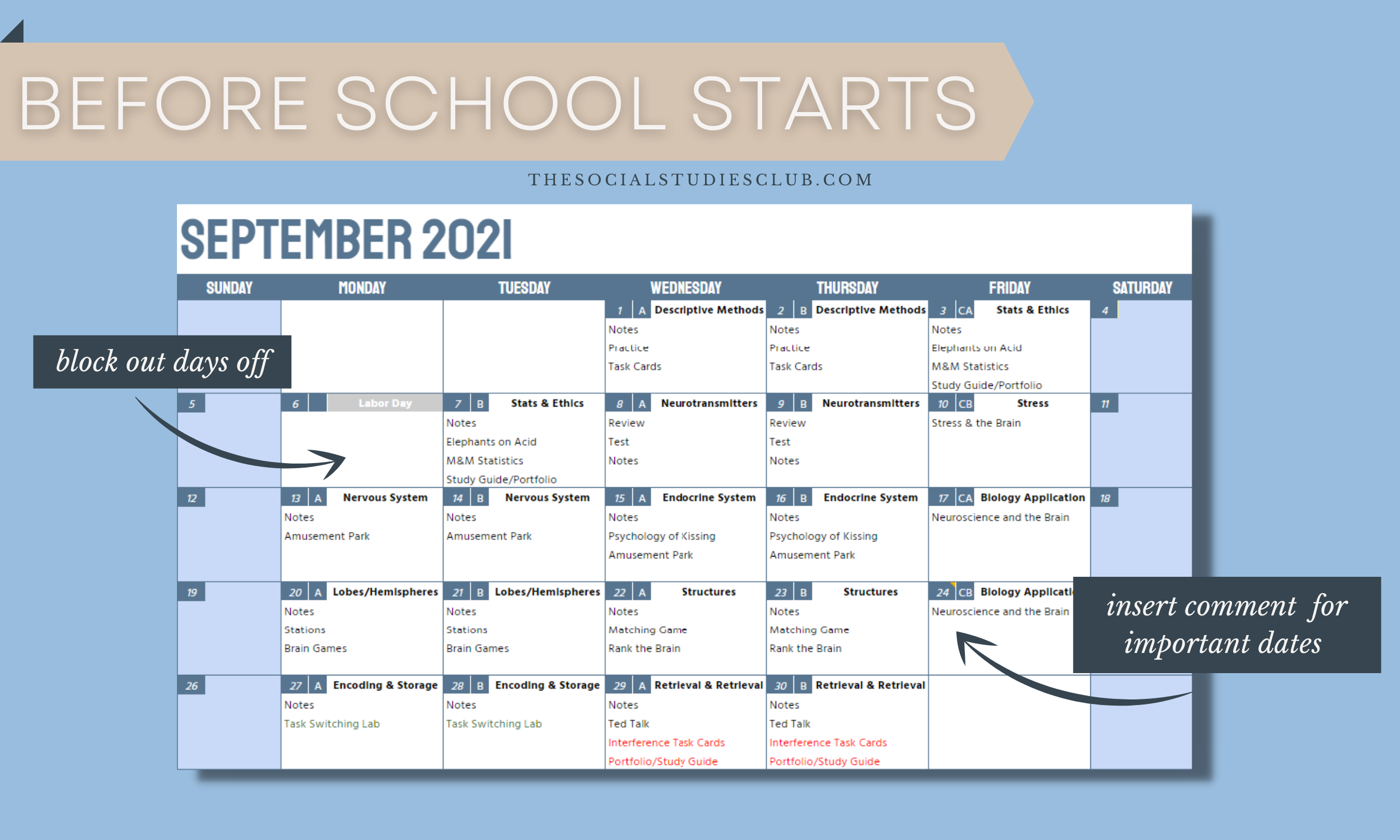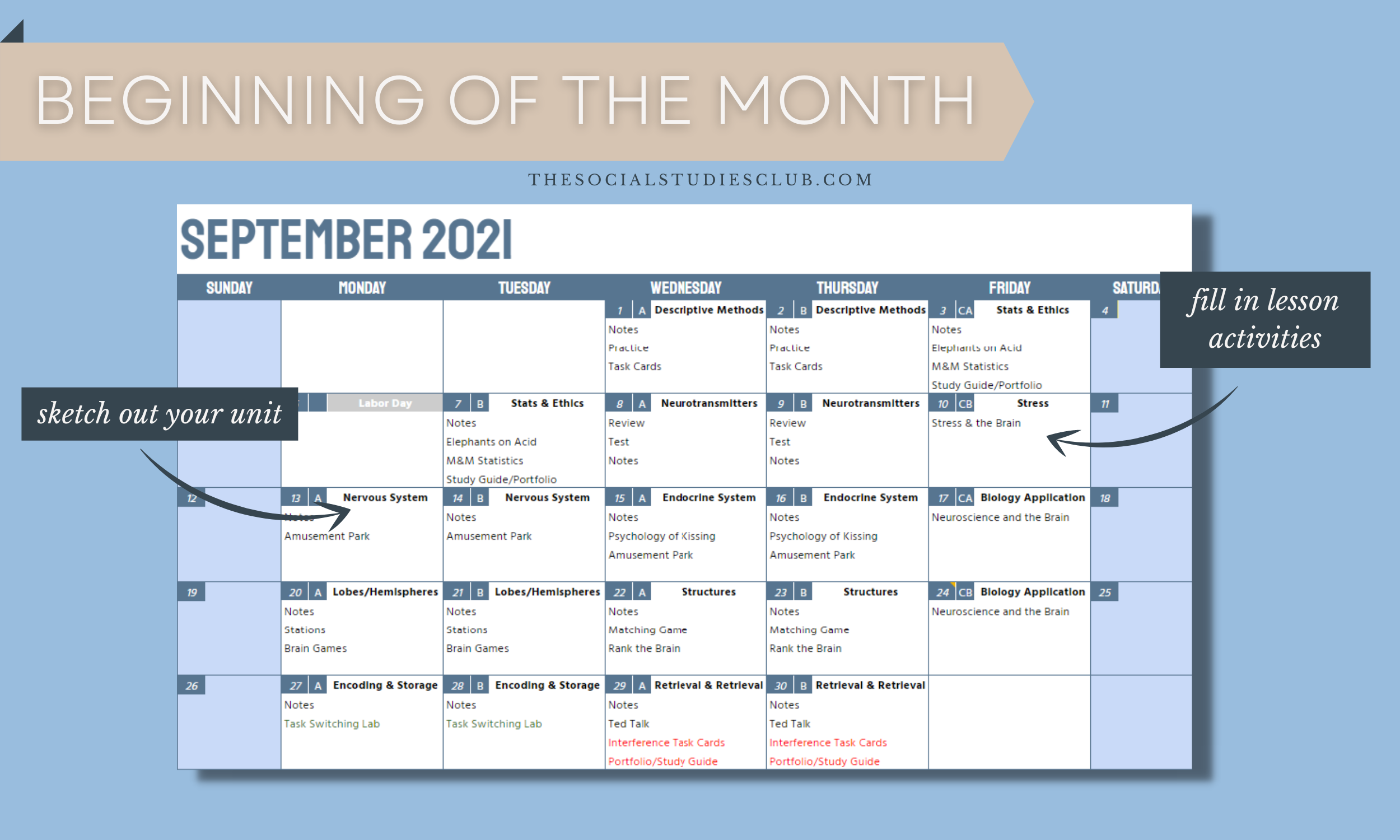
Do you know what never gets taught in teacher school? How to create and set up a dang pacing calendar. Anyone else feel like they totally missed out on some non-existent Practical Skills for Teachers 1010 class? I know I do. 🙋♀️
After 5 years, I feel like I have this workflow down. I hardly have to think about setting up a pacing calendar anymore. Honestly, I could probably do it in my sleep. So stick around my friends, this is how you get that pacing calendar ready to go with the least amount of mental effort.

In this tutorial, I am using my Google Sheets Calendar Template. You can snag one here if you would like, or grab your paper planner or Google Doc. We’re not picky around here and you can totally adjust this system to your preferred method of planning.
BEFORE THE SCHOOL YEAR STARTS

Step 1: Block-Out Days Off
The first thing I like to do is go through and block out major dates that will impact my instructional time. For example, we have a fall break in October. I block out those dates by filling in the header with a bold color and labeling it. Other dates I do this for are Winter Break, Spring Break, President’s Day… You get the idea. We also have a PD-Day at the end of each quarter to wrap up grading, so I block those kinds of dates out, too.
Step 2: Make Note of Important Dates
Next, I move on to important dates that won’t necessarily impact my instructional time, but will still be important to note for pacing. I do this by adding a comment to the cell. I love using Google Sheets for this because any time I hover over the commented cell, it will pop up and let me know why that date is important. Examples of these types of dates are the end-of-term, midterms, end-of-semester, etc.
BEGINNING OF THE MONTH

Step 3: Check Previous Years’ Plans
Now I’m ready to start thinking about the content. I like to revisit the previous year(s) to see what worked, didn’t work, and what I wanted to change. I try to leave notes for myself (a lot of emphasis on the word try) and when I do it’s really helpful. This process of reviewing the previous year starts to jog my memory and get me thinking about how I want this year to go.
Step 4: Sketch Out the Unit
Now I start to decide how long I want to spend on topics and in what order. I try to put the unit number and lesson number followed by the topic. For example, if it’s my second unit, third lesson, and the topic is the Qin Dynasty it would look like this: 2.3 Qin Dynasty. I will place this info in the header for the day. I do this for the entire unit. It’s also at this point that I figure out a target date for the unit assessment. It’s not set in stone, but it gives me something to shoot for.
Step 5: Fill in Lesson Activities
This is the fun part! I go through my unit and I list out any activity I know works really well and will help meet my standards.
I don’t think about details too much here, this is just me brain dumping. Maybe it’s an activity I did last year that was a total hit, or I found a resource that I am dying to use, or somehow posted a lesson idea on IG that has inspired me. I love linking directly to lesson ideas and resources, which is one reason I love using Google Sheets to plan.
At this point I’m not too concerned with knowing the nitty-gritty, I’m really just trying to give myself a starting point for lesson planning.
A WEEK BEFORE

Step 6: Finalize the Details
I try to know the gist of what I’m teaching a week ahead. (Not always, sometimes I’m planning the night before.) I should already have some activities filled in from my brain dumping session earlier. Now is when I start to really think through where my students are at in the curriculum, what they need to work on, what I need to reteach, and how I am going to meet the standards for the unit specifically.
I think of the flow of my lessons, and try to switch up my methods of instruction to avoid being stale. This would be a good time to mention I teach 90-minute blocks. As I am choosing activities, I usually aim for about 3, 30-minute activities for each block. This isn’t a hard and fast rule, but more of a general guideline.
Step 7: Color Code
Okay, actually, this is the really fun part. I go through all the lesson activities that I’ve just planned and determine how much work they need to be ready for the students.
- If the lesson activity needs some editing or hasn’t been created yet I change the font to red.
- If the lesson activity can be copied or posted to Canvas, I change the color to green.
- Once the lesson activity is copied or posted and completely ready to go, I change the font to black.
I’m usually changing the font to black the day before or the day of the lesson, lest you thought I had my life that together.
EVERY (MOST) FRIDAYS

Step 8: Make Notes
As I mentioned above, I try really hard to make notes so that future me has some recollection of what to change for the future. I am not perfect at this reflection piece, but I cannot overstate its importance. The lessons I’ve reflected on are 100x better the next year. There is no doubt about it.
Whew. That was a LOT! It’s taken me a while to get this workflow down, but I’ve been doing basically this exact system for the past 4 years and it has been a game-changer.
This calendar basically lives as an open tab in my browser rent-free. I also bookmark it. I’m constantly adjusting, tweaking, and planning. It really never stops.
I have found that having routines, systems, and workflows like this are the number one way I have freed up mental space in my teacher-brain.
What types of routines, systems, and habits have you established to free up some mental space? I would love to hear your tips in the comments!
Your friend,
Madison

